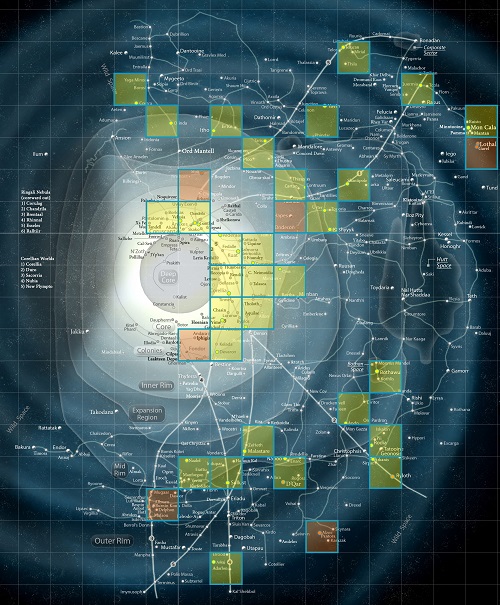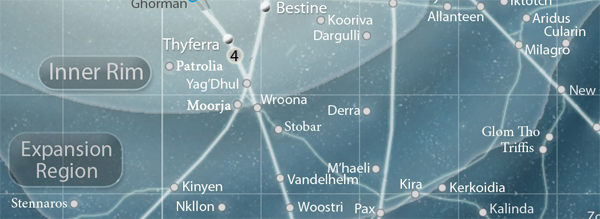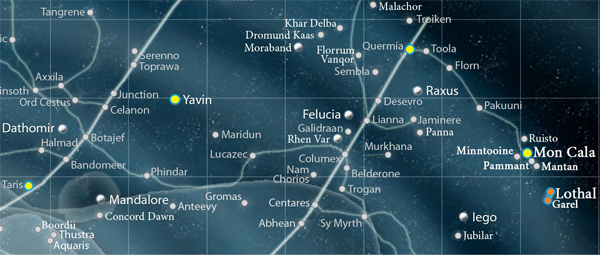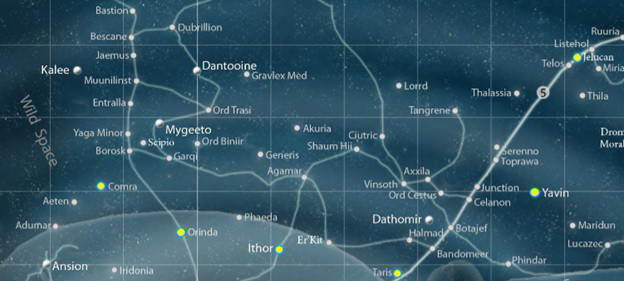It’s a year since the Battle of Endor. As the dust settles on and above Jakku, the Aftermath (pun intended) of the climactic battle of the Galactic Civil War leaves the New Republic the sole major galactic power. Rebuilding, reparations, and de-militarization are the orders of the day. Yet, even after the signing of the Concordance under an ancient tintolive tree on Chandrila, the galaxy’s political alignments are still taking form. Chancellors, emperors, presidents, and warlords across the galaxy now have to decide where their allegiances lie. The New Republic – egalitarian, democratic, and freedom-loving – is eager to expand its ranks, but equally content to let worlds choose their own paths. The wounds left by the Clone Wars, the Empire’s harsh rule, and the Galactic Civil War can now heal – but scars will remain.
Thanks to books like Chuck Wendig’s Aftermath trilogy, Bloodline, and various other canon sources, we now have a good idea of how the New Republic grew and expanded between Jakku and the destruction of Hosnian Prime. Yet, other powers emerged too. Large regions remained neutral, some to harbor the worlds that would be the harbingers of the First Order. The New Republic, victorious but still fledgling, comes of age in this galaxy. So, join me as we chart the political alignments and leanings of the galaxy in the years following the signing of the Galactic Concordance.
Note on Methodology
Before we dive into mapmaking, a few notes about my research for this article and our map. Thanks to friend of ETE and Stellar Cartographer-in-Chief Jason Fry, we had access to an updated map that places some of the newest canon worlds. For this article, we’ve chosen to have two categories of worlds listed:
1. New Republic Members (so marked with blue-rimmed yellow circles)
2. Unconfirmed/Friendly Worlds (so marked with blue-rimmed orange circles)

For New Republic members, the vast majority are confirmed in canon via a senator and/or mention of the world being a member. For this article, I’ve utilized a second methodology for a few worlds. Take Bothawui and Ando – members of both worlds’ native species are on Hosnian Prime in Bloodline, celebrating the dedication of the Bail Organa statue and/or shown to have politicians in the Senate compound. While it is possible these two worlds merely attended out of respect, for the sake of this article I’ve taken those inclusions to be signs of their membership in the New Republic.
For the Unconfirmed/Friendly category, I’ve highlighted worlds that are either confirmed to have friendly yet unaligned relations with the New Republic (see Ryloth) or worlds that were hotbeds of the Rebellion and therefore likely to have a close connection to the government, if not outright membership. It is these criteria that formed the basis of this article, so I wanted to clarify these points before jumping into the details.
Part One: The New Republic
As the New Republic emerges from the Galactic Civil War, it begins to expand its membership. Rebel-aligned worlds, stalwarts of the Old Republic, former Imperial worlds, and even some former Separatist worlds join the ranks of the new government. Based on our current count, there are 56 confirmed member worlds, of which 33 are shown with confirmed placements on this map. Regionally, that breaks down to the following:
|
Core Worlds |
Colonies |
Inner Rim |
Mid Rim |
Outer Rim |
Unknown Placement |
|
Alderaan |
Abednedo |
Birren |
Ando |
Akiva |
Ashaftan (species) |
|
Chandrila |
Commenor |
Cona |
Bothawui |
Anthan Spire |
Candovant |
|
Corellia |
Devaron |
Riosa |
Contruum |
Arkanis |
Frong |
|
Coruscant |
Ithor |
Askaj |
Gatalenta |
||
|
Ganthel |
Kashyyyk |
Bespin |
Hevurion |
||
|
Harloff Minor |
Malastare |
Comra |
Lonera |
||
|
Hosnian Prime |
Naalol |
Daxam IV |
Mirrin Prime |
||
|
Kuat |
Naboo |
Jelucan |
Orish |
||
|
Velusia |
Nakadia |
Mon Cala |
Torphlus |
||
|
Orinda |
Nag Ubdur |
Ubardia |
|||
|
|
Ottega |
Pamarthe |
|
||
|
|
Roche |
Quermia |
|
||
|
|
Tarsunt |
Rodia |
|
||
|
|
Uyter |
Sullust |
|
||
|
|
|
|
Taris |
|
|
|
|
|
|
Vashka |
|
|
|
|
|
Yavin IV |
|
At first glance, this list shows the broad reach of the New Republic, save the notable exception of having (as of yet in the current canon) confirmed members in the Expansion Region. However, once you start placing pins in the galactic map, an interesting narrative appears for each region.
Core Worlds and Colonies
 Like the Galactic Republic before it, the New Republic maintained a strong membership among the ancient worlds of the Galactic Core. The Arrowhead, also known as the Inner Core, was the cradle of the Old Republic. Strategically located at the nexus of three major trade routes (Perlemian, Corellian, and Hydian), it contains many New Republic members, most notably Coruscant, Alderaan, Kuat, Corellia and Chandrila, its first captial. In the Southern Core, Hosnian Prime was a key member, both as a New Republic military academy and later as the capital by the time of The Force Awakens. The region’s prominence in galactic politics and governance continues, as it has for millennia.
Like the Galactic Republic before it, the New Republic maintained a strong membership among the ancient worlds of the Galactic Core. The Arrowhead, also known as the Inner Core, was the cradle of the Old Republic. Strategically located at the nexus of three major trade routes (Perlemian, Corellian, and Hydian), it contains many New Republic members, most notably Coruscant, Alderaan, Kuat, Corellia and Chandrila, its first captial. In the Southern Core, Hosnian Prime was a key member, both as a New Republic military academy and later as the capital by the time of The Force Awakens. The region’s prominence in galactic politics and governance continues, as it has for millennia.
The Colonies, like their neighbors in the Core, also seem to be active in the New Republic. Industrial powerhouse Commenor, Abednedo (home of the now-ubiquitous species of the same name), and Devaron are among the worlds who sent representatives to the Senate. Located on or near strategic trade routes, these worlds bolster the New Republic’s strength in the galaxy’s central regions.
Inner Rim and Expansion Region

While the Inner Rim seems to have pockets of NR control, the Expansion Region currently appears to be entirely devoid of confirmed membership. These are the types of observations that made this article so much fun to compile. Why is such a large region lacking NR representation? Are the worlds there uninterested or unable politically to join the new government? Are they in the thrall of another power? Or has the canon just not gotten around to them yet? There is a story to be told there for sure.
The Mid Rim

This region enjoys strong membership in the New Republic. The strongest concentrations are in the Slice and the Trailing Sectors, with key worlds like Naboo, Malastare, Bothawui, Kashyyyk, and Contruum signaling the extent to which the region is aligned with the new government. Given the fact that the Rebel Alliance mounted a large but unsuccessful campaign to liberate the Mid Rim post-Yavin, it’s possible that many worlds in the region remember their commitment. In addition, in both the old canon and new, the region was long exploited by the Empire for resources, which would further explain the high concentration of membership.
The Outer Rim Territories

The Outer Rim is one of the more fascinating regions. It contains both lawless backwaters and advanced, cosmopolitan worlds. In analyzing the New Republic membership in this large swath of space, it starts to become apparent that many of the key worlds are on or near major trade routes. The New Republic, focused on rebuilding galactic trade and infrastructure, would be keen to keep these routes flowing. Sullust on the Rimma Trade Route, Taris on the Hydian Way, and Quermia at the edge of the Perlemian Trade Route would give the government the means to patrol and protect these vital galactic arteries. The region is also home to Mon Cala, key Alliance and New Republic member, as well as Telaris, the primary Rebel construction site for capital ships during the Galactic Civil War.

All of this combines to paint a picture of a New Republic that grew and expanded primarily in the Arrowhead, Southern Core, the Slice, and the Trailing Sectors. However, it leaves large portions of the galaxy potentially without a strong NR presence, which raises a lot of interesting questions and provides some fun fodder for making assumptions about why this is the case. It also provides some potential clues to the locations of minor powers.
Part Two: New Republic allies and probable members
In compiling this article, it became apparent that it would be important to highlight worlds that are either friends of the New Republic or worlds that are likely to be members but as of yet are unconfirmed. Pablo Hidalgo’s Propaganda book first mentioned the idea that there are many systems that have friendly relations with the New Republic, but didn’t become outright members. We see a specific example of this in Claudia Gray’s Bloodline, in the form of Ryloth. The Twi’lek homeworld suffered greatly during both the Clone Wars and under a brutal occupation by the Empire. While many of its citizens joined the Alliance and later served in the New Republic, the world never formally joined the new Senate. However, former Rebel pilot Yendor became its official emissary, serving as a voice for Twi’leks in the new government.
In terms of probable members, some stand out almost immediately. Take Pantora. In Wendig’s trilogy, we see Pantorans serving the New Republic in multiple forms – as pilots, officers, politicians, media personalities, etc. This points to Pantora either being an outright member or a world on very good terms with the New Republic, to a degree that many of its citizens join the government.
Another category of probable members comes from worlds that have a strong history/connection to the Rebel Alliance; Lothal, Garel, and Onderon being primary examples. These worlds would likely find themselves members in the new Senate, or at the very least be on friendly terms with the New Republic. As the new canon, specifically the post-Jakku era, continues to develop, worlds like these may end up being confirmed members.
Part Three: Separatist successors and criminal powers
In Empire’s End, we are given brief details on some emerging powers that are rising in the margins of the galaxy as the war between the New Republic and the Empire comes to a close. In Legends, the galaxy had a lot of minor powers, though their size and scope were always vastly inferior to the New Republic (a hyperpower in the old EU) and the Imperial Remnant (eight sectors, the next largest power). Two of the new powers hearken back to the galaxy’s previous major conflict, the Clone Wars.
The New Separatist Union and Confederacy of Corporate Systems are an interesting pair. The fact that both have elements of the former Separatist Alliance/Confederacy of Independent Systems in their names implies a connection, yet also an important distinction. In the case of the former, the New Separatist Union reminds me more of the “true believer” Separatists we seldom saw but were always told were there. Think of the worlds in the Separatist Parliament or worlds with genuine grievances against the Old Republic at its twilight. Could this be an assembly of worlds like Raxus, Felucia, Saleucami, and Murkhana? The Confederacy of Corporate Systems seems to represent the darker, more profit-driven side of the Clone Wars Separatists. One immediately imagines Neimoidia, Scipio, Skako, and other corporate-controlled worlds being among its members.
How do these two powers view each other, let alone the New Republic? In the case of the New Separatist Union, are these the worlds that The Force Awakens Visual Guide mentioned joined the New Republic once it became clear that the new government wouldn’t be based on Coruscant? Did either of these powers come into conflict with each other? The potential in these sorts of stories is endless.
 At the other end of the spectrum, we have powers of a less unified nature. Namely, Hutt Space and the Sovereign Latitudes. These regions are more lawless, more feudal in nature, and frankly ripe with storytelling potential! In Legends, Hutt Space had the distinction of being one of the largest secondary powers in the galaxy, including a legacy pre-prequel trilogy of controlling huge swathes of the Mid Rim. In the new canon, we learn that following the collapse of the Empire, Hutt Space is thrown into turmoil. Clans turn on each other, vying for power in the vacuum left by Jabba the Hutt. Former slave worlds rise up against their Hutt oppressors, gaining freedom. As the New Republic rises and slavery is abolished, the Hutts also face the rise of additional criminal powers, such as Kanjiklub and a revitalized Black Sun.
At the other end of the spectrum, we have powers of a less unified nature. Namely, Hutt Space and the Sovereign Latitudes. These regions are more lawless, more feudal in nature, and frankly ripe with storytelling potential! In Legends, Hutt Space had the distinction of being one of the largest secondary powers in the galaxy, including a legacy pre-prequel trilogy of controlling huge swathes of the Mid Rim. In the new canon, we learn that following the collapse of the Empire, Hutt Space is thrown into turmoil. Clans turn on each other, vying for power in the vacuum left by Jabba the Hutt. Former slave worlds rise up against their Hutt oppressors, gaining freedom. As the New Republic rises and slavery is abolished, the Hutts also face the rise of additional criminal powers, such as Kanjiklub and a revitalized Black Sun.
The Sovereign Latitudes, a pirate nation forming on the fringes of the galaxy, controls a Super Star Destroyer. If that combo right there doesn’t scream “there is a story here that needs to be told”, nothing does. Part survival of the strongest, part personal freedoms above all else (including the right to plunder!), this power represents another interesting take on governance in a post-Imperial galaxy.
Part Four: The First Order
No article on galactic cartography would be complete without some mention of the First Order. In reality, there are two facets to the First Order. The first is its public face, composed of Centrist worlds that joined, then left, the New Republic. The second is the militaristic, aggressive side that has been secretly growing in strength and size for two decades. Much is still unknown about the First Order, especially about how much space it truly controlled in the known galaxy prior to TFA. How many Centrist worlds left the New Republic? How many sectors in the Unknown Regions did they control? These are still unclear, though based on the evidence we have so far, a general narrative appears.
For starters, we have the portrayal of First Order Space in Before the Awakening. In it, we learn that the New Republic and First Order are separated by an unaligned buffer zone in the Trans-Hydian Borderlands. When you then consider that there are nearly no members of the New Republic in the New Territories, we suddenly get a good idea of where a good chunk of the First Order’s territory in the known galaxy might be located. Coincidentally or not, it is the same region that was the home of the Imperial Remnant in Legends.

Note that Comra and Orinda are Centrist worlds. Could the First Order’s main swath of territory be everything west of the Hydian Way and north of Ithor? If so, that is a large section of space, with access to major hyperlanes. How many more worlds and sectors are hiding in the Unknown Regions? Are there small pockets of First Order Space within the New Republic? We know thanks to Propaganda that the New Republic was willing to let Centrist worlds choose to freely leave. Could the large blanket that is New Republic space have patches of First Order territory stitched into it? How will this affect the state of the galaxy in The Last Jedi?
Conclusion
As the sequel trilogy continues to unfold and the gaps in the years between Return of the Jedi and TFA get filled in, storytellers would do well to look at how the New Republic evolved, as well as look for opportunities to craft stories involving other powers. A former Hutt slave world liberates itself and petitions the New Republic for membership. The New Separatist Union contemplates joining the New Republic, but lingering distrust among certain former Republic worlds threatens to scuttle the talks. The Confederacy of Corporate Systems enforces a blockade over neutral worlds in the Trans-Hydian borderlands, prompting the New Republic to debate taking action.
In short – the possibilities truly are endless!

Wow!This article was very interesting and informative
This was probably one of the nerdiest, most incredible articles ever
Thank you for the replies! I’m glad you enjoyed it, researching it and writing it was a super fun process. I view this article as a WIP to a certain degree, as the new canon reveals more stuff I can add to it. The addition of Ganthel, for example, was a last minute one thanks to the Join the Resistance books.
It’s also fun imagining how things progress for the New Republic in particular post-Jakku, plus guessing what worlds are likely to join the Senate as the new government grows.
That was awesome, from where have you taked the galaxy images?
We modified them to better serve the piece but the originals are from the Essential Atlas.